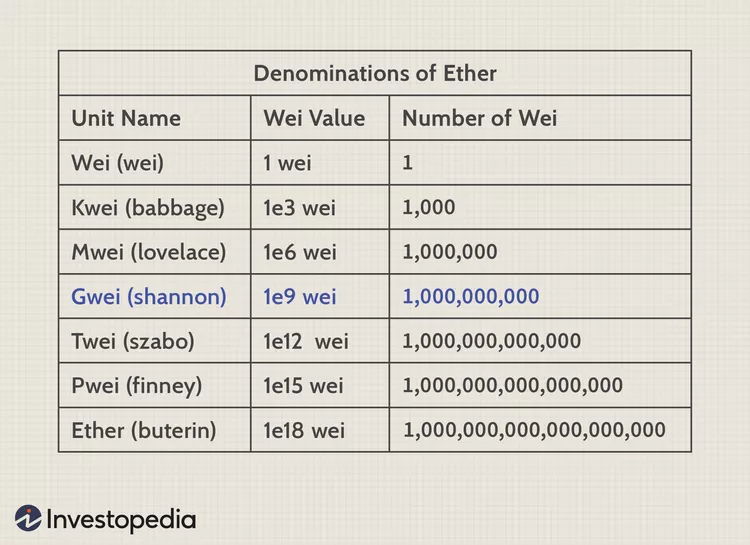When transacting on Ethereum or executing a smart contract, you pay a “gas fee.” These fees are denominated in Gwei, which might seem odd since Ether (ETH) is Ethereum’s native currency.
Well, Gwei is ETH, and technically, it is a denomination of cryptocurrency.
The Ethereum network uses a system of units to represent different denominations of ETH. This system allows Ethereum to handle a variety of transaction sizes and complexities, ensuring efficient management of gas fees and operations. At the base is Wei, the smallest unit, where one Ether equals 1 quintillion Wei. As we move up, we get Gwei halfway through the scale; it equals 1 billion Wei.
Ethereum Wallets, explorers (like Etherscan), and dApps all quote gas prices in Gwei because it has become the standard unit for gas fees.
Why Use Gwei?
The short answer: Gwei is a convenient middle ground. It balances precision with usability.
Ethereum transactions involve handling very small fractions of ETH, which can lead to unwieldy decimal places if expressed in full ETH. Gwei, being 1 billionth of an ETH, provides a readable and precise way to handle gas calculations without excessive decimal places.
Also, gas fees fluctuate based on network demand. If fees were expressed in full ETH, users would have to deal with extremely tiny decimal values. Instead, using Gwei simplifies the process—it’s easier to compare “30 Gwei” vs “50 Gwei” than “0.000000030 ETH” vs “0.000000050 ETH.”
There is no documented history as to when “gwei” became the standard unit for paying gas fees on Ethereum. In fact, the Ethereum Whitepaper did not make a single mention of the term “gwei”
How Are Gas Fees Calculated?
Since Ethereum’s London Upgrade (August 2021), gas fees consist of:
- Gas Limit – Maximum gas a user is willing to spend (e.g., 21,000 units for a basic transaction).
- Base Fee – A required amount that adjusts based on network demand.
- Tip (Priority Fee) – An optional amount users add to speed up transactions.
Example Calculation:
If the gas limit is 21,000, the gas price is 100 Gwei, and tip is 10 Gwei:
Total Cost = 21,000 × (100 + 10) = 2,310,000 Gwei = 0.00231 ETH

Gwei and Other the Ethereum Unit System
As earlier mentioned , “wei” is the smallest unit of measurement for Ether. There are six more units aside from Gwei.
Ethereum’s unit system is quite interesting because it pays tribute to some of the most influential figures in cryptography, computing, and digital currencies. This is similar to how US dollar bills feature historical figures: the $100 bill has Benjamin Franklin, and the £5 note in the UK has Winston Churchill. In Ethereum’s case, its denominations are named after pioneers who helped shape the world of blockchain and digital innovation.
Let’s break down the significance of each unit and the legendary figures behind them:

-
Wei (wei)
This is the smallest unit of Ethereum (1 ETH = 10¹⁸ Wei). It is named after Wei Dai, a cryptographer best known for “B-money”, a theoretical digital currency that introduced key ideas later used in Bitcoin and Ethereum. Dai’s concepts of decentralized money without government control laid the groundwork for today’s cryptocurrencies.
Notably, regardless of their magnitude, all upward units also have another name that carries the “Wei” suffix, with different prefixes indicating their scale. This naming convention follows the metric system, where prefixes like kilo-, mega-, and giga- help define multiples and subdivisions of a unit.
-
Kwei (babbage)
This unit is named after Charles Babbage, an English mathematician and inventor. He developed the first automatic computing engines in the 1800s, which laid the foundation for modern computers. As a decentralized computing network, Ethereum honours him for his visionary ideas.
-
Mwei (lovelace)
This is named after Ada Lovelace, who is often called the world’s first programmer. She was the daughter of the poet Lord Byron and a brilliant mathematician. Lovelace wrote the first-ever algorithm for a computing machine, predicting that computers could do more than just crunch numbers, an idea that directly ties into smart contracts on Ethereum.
-
Gwei (shannon)
Named after Claude Shannon, the father of information theory. His work in cryptography and digital communication forms the backbone of modern computing and blockchain encryption. Gwei being widely used for gas fees on Ethereum makes his contribution even more relevant to users today.
-
Twei (szabo)
Named after Nick Szabo, the man who invented the concept of smart contracts. Long before Ethereum existed, Szabo theorized digital contracts that could execute automatically, just like today’s Ethereum smart contracts. Many also believe he could be Bitcoin’s mysterious creator, Satoshi Nakamoto.
-
Pwei (finney)
Named after Hal Finney, one of the earliest Bitcoin developers. He was the first person to receive Bitcoin from Satoshi Nakamoto and played a key role in refining blockchain technology. By naming a unit after him, Ethereum acknowledges his groundbreaking contributions to cryptocurrency.
-
Ether (buterin)
Finally, the base unit of Ethereum, Ether (ETH), is named after Vitalik Buterin, Ethereum’s creator. He built Ethereum as a more flexible and programmable blockchain, enabling smart contracts, DeFi, and NFTs. Buterin’s work has transformed the blockchain landscape beyond just digital currency.
Why This Naming System Is Unique
Ethereum’s naming convention isn’t just for show; it reflects the history of computing, cryptography, and digital money. It reminds users that Ethereum isn’t just a financial tool but a revolutionary computing platform built on the ideas of visionaries, mathematicians, and cryptographers.
So, next time you see Gwei in gas fees or hear about Wei in smart contracts, you’ll know that these aren’t just random names; they’re part of a deeper history that brought Ethereum to life.
Gwei and ETH’s Role in Ethereum’s Future
Ethereum is constantly evolving, and as it scales to meet growing adoption, gas fees and Ether (ETH) and therefore, Gwei’s role could change significantly.
Ethereum’s recent transition to Proof of Stake (PoS) with Ethereum 2.0 has already brought noticeable improvements. Enhanced scalability and reduced network congestion have led to more stable gas prices and a smoother user experience. Future upgrades, which Vitalik Buterin has hinted would focus on Layer 2 solutions, are expected to further optimize transaction processing and potentially drive gas fees even lower.
Gwei provides a flexible system to keep transaction costs manageable, but in a world of ultra-low fees, Ethereum-based services might start quoting prices in even smaller units, shifting decimals the way fiat currencies sometimes do during inflation or deflation.
There is also the intriguing possibility that future technological breakthroughs could reduce or even eliminate the need for gas fees altogether. Should that occur, the distinction between ETH and its subunits might become less critical.
Ethereum’s roadmap is packed with upgrades around security, efficiency, and sustainability, and how users interact with transaction costs could fundamentally change. So, the idea of Gwei becoming isn’t something we can 100% rule out.
However, until such a paradigm shift is realized, Gwei remains a key part of Ethereum’s usability. And as long as gas fees exist, Gwei (or something like it) will likely stick around.
Disclaimer: This article is intended solely for informational purposes and should not be considered trading or investment advice. Nothing herein should be construed as financial, legal, or tax advice. Trading or investing in cryptocurrencies carries a considerable risk of financial loss. Always conduct due diligence.
If you would like to read more articles like this, visit DeFi Planet and follow us on Twitter, LinkedIn, Facebook, Instagram, and CoinMarketCap Community.
Take control of your crypto portfolio with MARKETS PRO, DeFi Planet’s suite of analytics tools.”
The post What is Gwei and Why It Matters for Ethereum Users appeared first on DeFi Planet.

